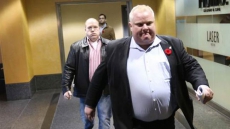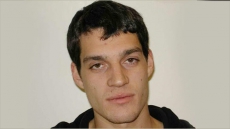TORONTO - Former NHL rookie Steve Moore can finally move past the on-ice attack that ended his career, he said Thursday, unburdened by a decade-long legal battle that inched through the courts.
Moore's multimillion-dollar suit against Todd Bertuzzi and the Vancouver Canucks over the infamous hit in 2004 was settled shortly before the scheduled Sept. 8 start of the trial.
It brings "mixed emotions," Moore said in a statement, recalling both the difficult years for his family and the "compassion and encouragement" he received along the way.
"The injuries I sustained in my rookie year, the years I spent trying to return to my NHL career, and dealing with the loss of my career and the ensuing legal case, have been long and trying experiences," Moore wrote.
"While nothing replaces the loss of one's dream, I am happy my family will no longer be burdened by an unresolved legal case, and I am grateful to be able to move forward."
The terms of the settlement are confidential.
Bertuzzi's lawyer confirmed the settlement two weeks ago, but Moore's lawyer, Tim Danson, said it's his opinion that there was no "binding and enforceable settlement until the language of the settlement documents was agreed to by all parties," which he said happened Thursday.
Moore, now 35, wrote that he looks forward to continuing to bring attention to the prevention and treatment of concussions and other head and neck injuries in sport through The Steve Moore Foundation.
"While my own hockey career was cut short, my love for the game has never diminished," he wrote.
The notorious hit happened on March 8, 2004. Bertuzzi, then playing for the Vancouver Canucks, hit Moore from behind, sending the hapless Colorado Avalanche rookie crashing face-first to the ice and leaving him with a concussion and fractured vertebrae.
In an interview earlier this year, he told The Canadian Press he still suffers from headaches and low energy. The lawsuit, he said, was not so much about the money as being compensated for the loss of his dreams.
"I lost my entire career in my rookie year," he said at the time. "I think any player put in that situation would do the same thing. I can't recover anything else. I can't recover my career, the experience of living out my dream from the time I was two and half years old of playing in the NHL."
Moore had alleged in his lawsuit that the Canucks had put a bounty on his head following his check that left their captain, Markus Naslund, injured.
Major retaliation was expected after Moore flattened Naslund with an open ice hit that put Vancouver's scoring star out with a concussion but was deemed legal by the NHL.
When the teams next met on March 3, with NHL commissioner Gary Bettman in the house, there were no incidents. The fireworks came in their March 8 game, a 9-2 Colorado win.
Moore squared off against Matt Cooke in the first period, a fight that was considered a draw. It appeared that was the end of it. But things got nasty in the third period. Moore was challenged again. He turned away. Bertuzzi skated up behind him, tugged on his jersey, then punched him from behind and fell on top of him as other players piled on.
Moore lay motionless on the ice in a pool of blood before being stretchered off and taken to hospital.
Bertuzzi was suspended for the rest of the regular season and the playoffs, which cost him about $502,000, and he didn't play during the 2004-05 lockout season. But he was reinstated in 2005-06 and has since continued his career, most recently with Detroit.
Bertuzzi also pleaded guilty to criminal assault causing bodily harm for the hit and was sentenced in December 2004 to one year probation and 80 hours of community service.
What followed was about 10 years of legal wrangling.
Moore attempted to file a lawsuit against Bertuzzi in Denver in February 2005, but the judge ruled it would be better handled in Canada. He ultimately succeeded in filing his lawsuit against Bertuzzi, the Canucks and then-parent company Orca Bay a year later. Even after filing suit, the case continued to be marred by various delays, eventually scheduled for trial more than 10 years after the incident.





